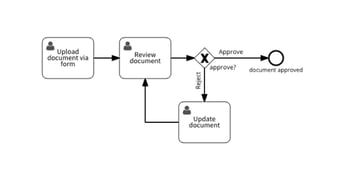
BPM for IT Leaders: The Unfiltered Truth About What Actually Works
Look, you've been around the block. You've seen ERP implementations go sideways, watched digital transformation initiatives burn through budgets, and sat through enough vendor pitches to know when you're being sold versus when you're being helped.
So let's cut through the noise and have a real conversation about Business Process Management: what it actually is, where it genuinely helps, and more importantly, where it doesn't.
The BPM Market Reality Check
The numbers tell an interesting story. The global BPM market is projected to explode from $20.38 billion in 2024 to $61.17 billion by 2030, a 20.3 percent compound annual growth rate. That's not hype; that's real money chasing real problems.
But here's the part the sales brochures won't tell you: only 15 percent of firms are actually happy with their BPM implementation results.
Let that sink in. 85 percent dissatisfaction rate.
That's not because BPM doesn't work. It's because most organizations get it wrong. They either pick the wrong processes, underestimate the change management required, or treat it like a technology problem when it's really a people problem with a technology component.
What BPM Actually Is (and Isn't)
Business Process Management is the discipline of designing, executing, monitoring, and optimizing the repeatable workflows that run your business. Not one-off projects. Not ad-hoc tasks. Repeatable, predictable processes that happen over and over.
Think invoice approvals, employee onboarding, IT service requests, and contract management. The boring stuff that eats up 60 percent of your team's time and causes 80 percent of your operational headaches.
BPM gives you three things:
- Visibility: You can finally see what's actually happening versus what you think is happening
- Control: You can enforce compliance and governance without becoming the workflow police
- Optimization: You can measure, improve, and prove ROI
BPM is not project management software. It's not task management. And it's definitely not a silver bullet for organizational dysfunction.
The Three Types of BPM (Choose Wisely)
Not all BPM is created equal. Understanding which type you need prevents expensive mismatches:
Integration-Centric BPM
This handles processes that primarily flow between your existing systems (ERP, CRM, HRMS) with minimal human interaction. Think purchase order workflows that span procurement, finance, and inventory systems.
When to use it: System-to-system automation where speed matters more than human judgment.
Human-Centric BPM
This focuses on workflows requiring human approvals, decisions, and collaboration. Most processes in IT departments fall here: change requests, access provisioning, and incident escalations.
When to use it: Multi-step approvals, cross-departmental collaboration, processes requiring judgment calls.
Document-Centric BPM
This manages workflows where a document is the centerpiece: contracts, compliance forms, technical specifications.
When to use it: Regulated industries, contract lifecycle management, document-heavy compliance workflows.
Most BPM platforms claim they handle all three. Most are really good at one. Know which one matters most to your use case.
The Real ROI Question
Every executive wants to know: "What's the payback period?"
Gartner research shows BPM increases project success rates by 70 percent. Organizations using hyperautomation can reduce operational costs by 30 percent. Increased BPM usage can boost productivity by 50 percent.
Those are impressive numbers. But they come with a catch: these gains only materialize if you avoid the common traps.
The Implementation Reality
37 percent of organizations cite implementation costs as the primary barrier to BPM adoption. And they're not wrong to worry. BPM projects fail for predictable reasons:
- Starting Too Big
You don't implement BPM across your entire enterprise on day one. You start with one painful, high-volume process. Something simple enough to succeed with but meaningful enough that people notice.
The purchase requisition process takes 11 days and 7 approvals. That's your pilot. Not the entire procure-to-pay lifecycle.
- Treating It Like an IT Project
BPM projects led by IT fail because (and here's the uncomfortable truth) IT doesn't own the processes. Finance owns the invoice approval process. HR owns onboarding. Operations owns change management.
BPM needs a business owner with skin in the game and authority to change how work gets done. IT provides the platform and expertise, but if you're driving it, you're setting yourself up for blame when adoption tanks.
- Underestimating Change Management: 76 percent of business owners say process complexity and interdependency cause low BPM success rates. But complexity isn't the real killer—resistance is.
Your team has worked around that broken approval process for three years. They've got their workarounds, their email chains, their informal escalation paths. BPM threatens that comfort zone.
If you don't invest in training, communication, and making the new process easier than the old one, you'll end up with a beautiful BPM system that nobody uses.
When NOT to Use BPM
Real talk: BPM isn't always the answer. Here's when to walk away:
Creative, Non-Repeatable Work
If every project is unique (true custom development work, strategic consulting engagements), BPM will feel like handcuffs. Use project management tools instead.
Processes You Don't Understand Yet
Don't automate confusion. If you can't map the current state on a whiteboard and have everyone nod in agreement, you're not ready for BPM.
Broken Processes You're About to Kill
Automating a process you're planning to eliminate in six months is just expensive procrastination.
When You Lack Executive Sponsorship
No executive sponsor means no governance authority, which means no adoption, which means expensive shelfware. Don't start.
The 2026 BPM Landscape: What's Actually Changing
The BPM market is evolving fast. Here's what's real versus what's buzzword bingo:
Low-Code Is Eating Traditional BPM
Low-code platforms are projected to capture over 70 percent of the process management market by 2025, up from under 25 percent in 2020. This matters because low-code democratizes BPM—business analysts can build and modify workflows without waiting for IT.
The downside? Low-code can create technical debt if governance isn't tight. You'll end up with 50 citizen-developed processes that nobody can maintain when that business analyst leaves.
Process Mining Changes Everything
Process mining tools analyze your system logs to show you what's actually happening, not what people say is happening or what the documented process claims.
Turns out, businesses rank process mining at 39 percent and automation tools at 56 percent as the top BPM capabilities they want. Why? Process mining eliminates the months-long analysis phase and shows you exactly where the bottlenecks are.
AI and Hyperautomation (But Keep Your Expectations Realistic)
Yes, AI is coming to BPM. 67 percent of organizations plan to increase investment in generative AI integration to improve business operations.
But remember: AI automates decisions, not judgment. Use it for pattern recognition, data extraction, and predictive analytics. Not for replacing the human who needs to decide whether this particular vendor contract requires legal review.
Mobile BPM Isn't Optional Anymore
Your team works remotely. Your executives approve from their phones. Your vendors submit requests from the field. If your BPM platform doesn't have a real mobile experience (not a responsive web app but actual mobile apps), you're forcing people into workarounds from day one.
The Security and Compliance Reality
Here's what nobody talks about until it's too late: BPM platforms become treasure troves of sensitive data and audit trails. That's good for compliance. That's terrifying for security if not handled properly.
What you need:
- Role-based access control that actually works (tested, not theoretical)
- Audit trails that survive for your industry's retention requirements
- Data sovereignty controls if you're in regulated industries
- Integration with your identity management system (SSO at minimum, SAML better)
- Disaster recovery that includes your process state, not just the platform
Cloud-based BPM captured 61.8 percent market share in 2024, but hybrid architectures are growing fastest. That's not a coincidence. Regulated industries need on-premise control for sensitive data while enjoying cloud scalability for everything else.
The Implementation Roadmap That Actually Works
After watching dozens of BPM implementations over the years, the pattern is clear. Here's what separates winners from cautionary tales:
Phase 1: Pick Your Battle Carefully (Week 1-2)
- Choose a process that's painful, high-volume, and measurable
- Document current state with the people who actually do the work
- Set specific KPIs: "Reduce approval time from 5 days to 24 hours" beats "improve efficiency"
Phase 2: Design for Adoption, Not Perfection (Week 3-4)
- Keep it simpler than the old process, not equivalent
- Build in quick wins: auto-approvals for requests under $500, instant notifications, mobile access
- Design the exception handling paths (because reality is messy)
Phase 3: Pilot with Believers (Week 5-8)
- Find a department head who wants this to work
- Run parallel with the old process for 2 weeks, then force-cut over
- Measure everything, fix the pain points daily
Phase 4: Scale with Proof (Month 3+)
- Show the results to skeptics with hard numbers
- Document the implementation playbook for the next process
- Build a center of excellence to govern and support
Notice what's missing? Six-month requirements gathering. Consultant-led process mapping workshops. Change boards that take 8 weeks to approve anything. If your BPM implementation timeline is measured in quarters, you're doing it wrong.
The Governance Conversation You Need to Have Now
Let's address the elephant in the room: who controls BPM in your organization?
Only 1 percent of firms have their business processes sufficiently under control to fully realize digital transformation benefits. That's because most organizations treat BPM as a tool instead of a discipline.
You need:
- A Process Owner Committee: Business leaders who own major process domains
- A BPM Center of Excellence: 2-3 people who understand the platform, train users, and maintain standards
- Clear Guardrails: What processes require approval to automate? What's off-limits?
- A Sunset Policy: Unused processes get archived after 6 months of inactivity
Without governance, you'll have 200 processes by year two and no idea which ones are mission-critical versus someone's abandoned experiment.
The Hard Truth About Vendors
Every BPM vendor claims they're different. Most aren't. Here's how to cut through the demo-ware:
Red Flags:
- "No-code" platforms that require professional services to build anything useful
- Pricing that's "custom" (translation: expensive and non-negotiable)
- Requiring multi-year commitments before you've proven value
- No clear migration path if you need to leave
Green Flags:
- Reference customers in your industry who will take your call
- Transparent pricing published on their website
- Free trials that include the actual features you need (not gimped versions)
- Active user community and third-party integrations
- Clear API documentation (check this yourself—it's where the truth lives)
Where Kissflow Fits In
After everything we've discussed—the failures, the pitfalls, the hard truths—you need a platform that doesn't make the common mistakes worse.
Kissflow was built around a simple premise: BPM should be usable by the people who understand the processes, not just the people who understand code. It's a low-code platform that gives IT the control they need (governance, security, integration) while giving business users the autonomy they want (build, test, iterate without waiting for a development sprint).
What makes it different:
For IT Leaders:
- Enterprise-grade security and compliance controls
- Real SSO/SAML, not bolted-on authentication
- API-first architecture that integrates with your existing stack
- Governance controls that prevent citizen development chaos
- Deployment flexibility—cloud, hybrid, or on-premise
For Business Users:
- Visual process designer that doesn't require training
- Pre-built templates for common processes (because you shouldn't rebuild invoice approval from scratch)
- Mobile apps that actually work
- Collaboration features that match how people already work
For Your Budget:
- Transparent pricing that doesn't require enterprise negotiations
- Fast time-to-value (weeks, not quarters)
- Scalable from department-level pilots to enterprise deployments
Most importantly, Kissflow customers typically see results in their first process deployment, not after six months of implementation. Because at the end of the day, the best BPM platform is the one your team will actually use.
Get started with Kissflow to see how it handles your specific use cases. No sales pressure, no forced demos, just a straightforward trial that shows you whether it solves your problems.
Frequently Asked Questions
1. What's the difference between BPM software and simple workflow automation tools?
Workflow automation handles single, linear task sequences—like routing an approval from A to B to C. Business Process Management takes a broader view: it encompasses the entire lifecycle of designing, executing, monitoring, and continuously optimizing interconnected workflows across departments and systems.
Think of it this way: workflow automation fixes one leaky pipe, while BPM manages your entire plumbing system. BPM platforms like Kissflow provide visibility into how processes actually perform, enforce governance without micromanagement, and deliver measurable optimization data. If your organization runs multiple repeatable processes that span teams—invoice approvals, employee onboarding, IT service requests—you need BPM's holistic approach, not just isolated automation.
2. How long should a BPM implementation realistically take before we see results?
If your timeline stretches into quarters, something's wrong. Successful BPM implementations follow a focused 8-12 week pilot approach: two weeks to select and document a high-impact process, two weeks to design a streamlined solution, and four weeks to pilot with a committed team before scaling.
The mistake most organizations make is trying to automate everything at once. Start with one painful, high-volume process—something like purchase requisitions that currently take 11 days and 7 approvals. Platforms built for speed, like Kissflow, enable business teams to design and launch processes in weeks rather than months because they don't require heavy IT development cycles for every change.
3. How do I calculate the ROI of BPM to justify the investment to leadership?
Forget vague "efficiency gains." Build your business case around three concrete metrics: time recovered, error reduction, and compliance cost avoidance.
Start by measuring your current state: How many hours does your team spend on manual approvals, status chasing, and rework? What's the cost of compliance violations or audit findings in your industry? What revenue leaks occur from delayed processes like contract approvals or vendor onboarding?
Research shows BPM can reduce operational costs by 30% and boost productivity by 50%—but only with proper execution. For a credible ROI projection, pilot one process first. Kissflow customers often demonstrate measurable wins in their first deployment, which creates the internal proof points needed to expand funding for broader initiatives.
4. What are the warning signs that my organization isn't ready for BPM?
Three red flags should make you pause before investing in BPM:
First, you can't map your current process. If stakeholders disagree on how work actually flows today, you'll automate confusion rather than solve problems. Document the as-is state with the people doing the work before touching any software.
Second, no executive sponsor exists. BPM crosses departmental boundaries, which means it needs authority to change how work gets done. Without a business leader accountable for outcomes—not just IT supporting the platform—adoption will stall.
Third, you're planning to eliminate the process anyway. Automating something you'll sunset in six months is expensive procrastination.
Low-code BPM platforms like Kissflow lower the technical barrier, but organizational readiness still determines success. Get alignment first; technology follows.
5. Why do 85% of BPM implementations fail, and what separates the successful 15%?
Three patterns destroy BPM projects: scope creep, IT-only ownership, and underestimating resistance.
Scope creep happens when organizations try to automate their entire enterprise on day one instead of proving value with one focused process. Successful implementations start small, show results, then scale with proof.
IT-only ownership fails because IT doesn't own the processes—Finance owns invoice approvals, HR owns onboarding, Operations owns change management. BPM needs business owners with authority to redesign how work happens. IT provides expertise and governance, not sponsorship.
Resistance kills adoption. Your team has spent years building workarounds for broken processes. If the new BPM system isn't demonstrably easier than the old way—with mobile access, instant notifications, and fewer steps—people will bypass it.
Kissflow addresses these patterns by enabling business users to build and modify processes without IT bottlenecks, while giving IT the governance controls to prevent shadow automation chaos. The organizations that succeed treat BPM as a discipline, not a software purchase.
6. How does BPM help enterprises scale operations without losing control?
BPM standardizes workflows across departments, ensuring consistent execution even as volume grows. It adds governance, automation, and visibility so leaders can scale processes confidently while reducing errors and delays.
7. Why do CIOs treat BPM as a digital transformation foundation?
Because BPM connects people, systems, and data through structured workflows. It modernizes operations incrementally and supports enterprise-wide automation without disruptive system replacements.
8. What kinds of process gaps does BPM usually reveal?
BPM often exposes bottlenecks, redundant approvals, unclear ownership, and manual handoffs that slow operations. These gaps become measurable and fixable through workflow analytics.
9. How does BPM improve cross-department coordination?
It establishes clear routing, role-based ownership, and standardized handoffs between teams, eliminating confusion and reducing dependence on email follow-ups.
10. How does BPM support compliance-heavy industries?
Audit logs, enforced rules, approvals, and traceability help regulated teams prove adherence to internal policies and external standards.
11. How do enterprises sustain BPM improvements over time?
By continuously monitoring process performance and refining workflows through data-driven optimization, rather than one-time fixes.
Related Articles

![Business Process Automation: A Complete Guide with Examples [2025]](https://kissflow.com/hs-fs/hubfs/business_process_automation_a_complete_guide-2.webp?width=352&name=business_process_automation_a_complete_guide-2.webp)









